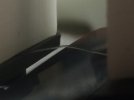- Joined
- Jun 4, 2010
- Messages
- 6,642
Just unboxed mine this morning, rec'd yesterday while at work and didn't get home till 8:30PM.
My kids helped me set it up before I took them to work and I was able to run a few tests.
First off I'd like to give a quick impression - unit is light, easy to understand and set up, no frills/none needed. I'd like to make one just like it only scaled up for cutting 3/8" sisal
My results based on very limited testing are showing reasonable consistency. I am seeing a bit of creep in that a delay under load seems to reliably produce lower values but I recall seeing a bit about this in the manual - need to reread that section. Will run a few more tests to see if I can pin down the difference - I suspect it is not a large margin. Adding shot until break point seems like I'm adding more than needed, but again probably not a significant enough amount of weight to mention.
My wife's Chicago utility kitchen knife XXC DMT burnished with smooth steel, supposed to be effective yet have an Oops margin of error=
163/158/168, I should maybe dull it up to the mid 200's
Tops CAT 1095 @ 28° inclusive, finished on Washboard with stock honing compound, my current EDU =
42/47/43
Jarvenpaa Puukko 26° same as above =
38/44/45
Serrated portion of my Frankenfolder, Fred Carter MK4 440C ground to fit Benchmade 720 frame =
101/94/104
Will have to continue as I get some more time, that's all for today. So far I like that the numbers coming back for similar prep across different knives are so close. Also numbers within each set seem to be well within reason. If I'm reading the manual correctly, the margin of error is +/- 10 grams.
Am I supposed to be adding the shot value to the existing 55 grams, or is my BESS value only what is added past the weight of the platen and piston (DE Razor drop)? My #s are just what has been added to make a drop.
Edit to add: am guessing folks are using the additional grams, otherwise some would be severing with less than full weight of platen and impossible to take a number...
Fun stuff!
Martin
My kids helped me set it up before I took them to work and I was able to run a few tests.
First off I'd like to give a quick impression - unit is light, easy to understand and set up, no frills/none needed. I'd like to make one just like it only scaled up for cutting 3/8" sisal
My results based on very limited testing are showing reasonable consistency. I am seeing a bit of creep in that a delay under load seems to reliably produce lower values but I recall seeing a bit about this in the manual - need to reread that section. Will run a few more tests to see if I can pin down the difference - I suspect it is not a large margin. Adding shot until break point seems like I'm adding more than needed, but again probably not a significant enough amount of weight to mention.
My wife's Chicago utility kitchen knife XXC DMT burnished with smooth steel, supposed to be effective yet have an Oops margin of error=
163/158/168, I should maybe dull it up to the mid 200's
Tops CAT 1095 @ 28° inclusive, finished on Washboard with stock honing compound, my current EDU =
42/47/43
Jarvenpaa Puukko 26° same as above =
38/44/45
Serrated portion of my Frankenfolder, Fred Carter MK4 440C ground to fit Benchmade 720 frame =
101/94/104
Will have to continue as I get some more time, that's all for today. So far I like that the numbers coming back for similar prep across different knives are so close. Also numbers within each set seem to be well within reason. If I'm reading the manual correctly, the margin of error is +/- 10 grams.
Am I supposed to be adding the shot value to the existing 55 grams, or is my BESS value only what is added past the weight of the platen and piston (DE Razor drop)? My #s are just what has been added to make a drop.
Edit to add: am guessing folks are using the additional grams, otherwise some would be severing with less than full weight of platen and impossible to take a number...
Fun stuff!
Martin
Last edited:


